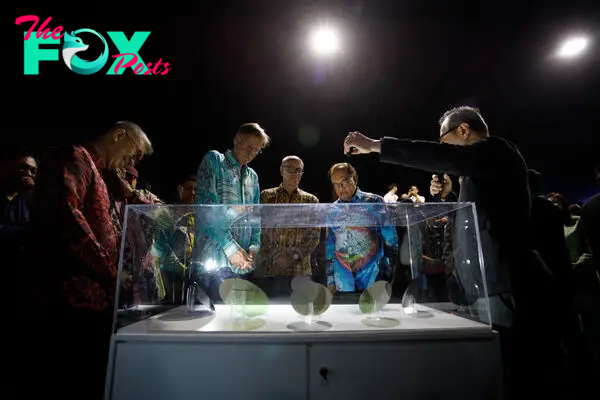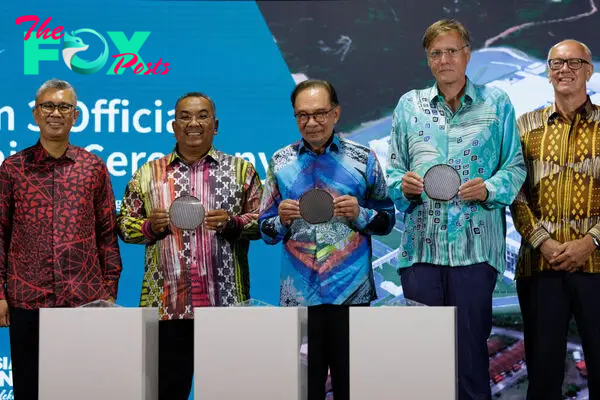Technology
How ‘Friendshoring’ Made Southeast Asia Pivotal to the AI Revolution
Employees entering Intel’s advanced PG8 foundry on the Malaysian island of Penang must take elaborate safety precautions. Not that they’re the ones at risk.
First, staff don blue shoe coverings, followed by a hairnet, plastic hood, facemask, bunny suit, latex gloves, and eye goggles. Finally, plastic boots are placed over those already-covered shoes with a special strap tucked into the wearer’s socks to “ground” them. For it’s not just a stray hair or skin flake that can be deadly to Intel’s latest artificial intelligence (AI) semiconductor chips—even the static shock from an unsuspecting pinky can measure 10,000 volts and fry their delicate circuitry.
“Static is a unit killer,” says Phynthamilkumaran Siea Dass, Intel’s director of assembly test manufacturing in Penang, as he leads TIME through interlocked doors into PG8’s cleanroom. “And we really don’t like killing units.”
It’s meticulous care emblematic of the precision engineering taking place these days on Penang, a tropical island perched off peninsular Malaysia’s west coast that for centuries was synonymous with betel trees, before the late 18th century arrival of British colonizers transformed it into a flourishing trading post. Today, Penang rivals South Korea and Silicon Valley as a vital hub producing the semiconductor chips that power the AI revolution.
As a part of this drive, Intel is investing $7 billion in new facilities in Penang, including an advanced packaging site codenamed “pelican” for transformative “3D” semiconductors—which stack chips on top of each other to boost performance—set to open early next year. As semiconductors chips themselves have exponentially advanced, so has the complexity of the backend work necessary for their deployment. Today, Intel uses its Penang and sister facilities in the nearby Kulim Hi-Tech Zone to assemble and test dozens of products including its Core, Xeon, and latest AI-enabled Meteor Lake chips.
“Malaysia is a very, very critical location in Intel's supply chain where we are not only doing manufacturing, assembly, and testing products, but we also have design,” says Keyvan Esfarjani, an executive vice president and chief global operations officer for Intel.
And it’s not just Intel; chipmakers and suppliers including Micron, AMS Osram, and Ferrotec are all investing big in Malaysia as firms look to decouple supply chains from China (a trend dubbed “China+1” diversification). Meanwhile, Chinese counterparts are also setting up shop here partly with a view to sidestepping U.S. tariffs and export controls, thrusting backend hubs like Malaysia to the forefront of the $520 billion global semiconductor industry.
In July, foreign investors plowed $1.3 billion into Malaysian bonds, the largest monthly iNFLow in a year. On Aug. 8, German semiconductor giant Infineon Technologies AG opened the world’s largest 200-mm silicon carbide power fabrication plant in Kulim as part of a $7.7 billion expansion. Penang alone attracted $12.8 billion in foreign direct investment (FDI) in 2023—more than the total it received from 2013 to 2020 combined—from companies sold on its solid infrastructure, decades of engineering expertise, as well as perks like 15-year tax breaks.
“Chinese, U.S., and European firms are all converging here,” Penang Chief Minister Chow Kon Yeow tells TIME in his Georgetown office. “We welcome all investments and are neutral in the sense that we do not take sides.”
Yet geopolitics continues to bubble in the background and many wonder for how long nations like Malaysia can play all sides, with some industry groups fearing the U.S. could start restricting products and equipment built in Malaysia by locally based Chinese companies. It’s a delicate balance; while the U.S. is the top source of FDI to Malaysia, China has been its largest trading partner for 15 consecutive years. Prime Minister Anwar Ibrahim has been fiercely critical of Washington’s backing of Israel over the Gaza crisis, and a recent survey found 75.1% of Malaysians thought the nation should align with China if forced to choose between the superpowers.
Speaking to TIME on the sidelines of the Infineon launch, Anwar stressed that Malaysia sought to benefit from the trade war without being dragged into it. “Some say maybe we're tilting somewhat,” he said. “I would say no, we maintain a very fiercely independent foreign policy and continue to engage [all sides]. But it's not easy to navigate this; people become very uptight about being with us or with them.”

It was 1972 when Intel—the world’s largest chipmaker by revenue—chose Penang for its first overseas production facility. Dubbed A1, that initial factory was constructed on the site of a paddy field so off-grid that the car carrying Andy Grove—Intel’s legendary future CEO and TIME’s 1997 Man of the Year—got stuck in a bog during an early site inspection and had to be dragged out by local staff.
Over half a century later, Intel’s facilities across Penang and Kulim are home to some 15,000 staff, working both to the clatter of industrial machinery and hum of climate-controlled offices. Inside its shimmering clean rooms, wafers are precision sliced into individual chips, mounted on a resin substrate, pumped with epoxy underfill, covered with metallic plates, heat-treated, and tested for defects. The only reminder from Intel’s mud-spattered local origins is Grove’s famous saying—“only the paranoid survive”—emblazoned on a stairwell wall.
It’s a maxim that neatly captures today’s industrial zeitgeist following a pandemic and simmering technology war that have upended global trade, prompting a frenzy of “friendshoring” or “nearshoring”—rather than prioritizing costs, partnering with countries more politically aligned and closer geographically—ostensibly to instill resilience into supply chains. In this regard, semiconductors are crucial—a typical car contains over 1,000 chips—and are poised to get more so following recent advances in AI.
Given today’s geopolitical climate, “what non-China customer would accept a supply plan that is anchored on China?” says Hassane El-Khoury, CEO of Arizona-based Onsemi, a $31 billion manufacturer of power semiconductors with operations in over a dozen countries including India, Malaysia, and Vietnam. Today, Onsemi aims to offer its products via two completely distinct supply chains within the same company, which “is very, very favorable from a customer perspective,” he adds.
However, at present Taiwan produces over 90% of the most advanced semiconductor nodes and China’s repeated threats to invade the self-governing island is a cause of significant anxiety. In response, the 2022 U.S. CHIPS and Science Act allocated $39 billion to semiconductor manufacturers to subsidize the opening of American foundries, including nearly $28 billion shared between Intel, TSMC, Samsung, and Micron, alone.
“The semiconductor ecosystem is critical and if you take out one player you could cripple the whole thing,” says Daniel Nenni, co-author of Fabless: The Transformation of the Semiconductor Industry. “So any type of rePetition or redundancy we can build in is always a good thing.”
Southeast Asia is also seeing a glut of investment with over $70 billion unveiled by the world’s top tech firms in recent months. Malaysia has in particular emerged as a hub for cloud and AI data centers, with recent pledges of $6 billion from Amazon Web Services, $4.3 billion from Nvidia, $2.2 billion from Microsoft, $2.1 billion from Bytedance, and $2 billion from Google.
In addition, the rise of “chiplets”—microprocessors of varying performance and providence fused together into bespoke chips—has boosted the intricacy and importance of back-end semiconductor work. With AI capabilities today being infused into everything from cars to refrigerators, there’s an explosion in demand for advanced chips. However, AI chips are extremely expensive and overkill for more mundane functions, making the ability to package small, advanced chips with much older, basic nodes a net win for functionality and cost. “Advanced packaging is becoming more and more important and where a lot of the action is going,” says Willy Shih, a professor at Harvard Business School.
Of course, Malaysia faces fierce comPetition as many countries vie to be the “plus one” in every multinational’s China+1 strategy, especially India, Vietnam, Thailand, and Mexico. Each comes with advantages and drawbacks. Proximity to the U.S. makes Mexico favored by firms focusing on American consumers. India is offering many billions of dollars in subsidies, though is hampered by a comparatively unskilled labor force, onerous red tape, and untested infrastructure. Vietnam and Thailand both welcomed huge investments by Apple and Microsoft respectively in recent months, but lack a ready supply of talent or preexisting tech ecosystem. This is where Malaysia—already the world’s sixth-biggest semiconductor exporter, packaging 23% of all American chips—excels.
“It's a really amazing semiconductor ecosystem they've developed specifically in Penang,” says Peter Hanbury, a semiconductor specialist at the Bain & Co. consulting firm. “It has all the different semiconductor players, their manufacturers, tool vendors, and assembly tests.”

Still, Malaysia is only too aware that it cannot afford to rest on its comPetitive advantage. In May, Prime Minister Anwar unveiled a three-phase $5.3 billion National Semiconductor Strategy including the training of 60,000 new engineers. “Malaysia realizes you cannot any longer just offer free land and local workers,” says Siobhan Das, CEO of the American Chamber of Commerce in Malaysia. “It's about the quality of the people put into those jobs.”
While the goal of international firms is to bolster supply chain resilience, for Malaysia and its competitors the impetus is to move up to higher value activities such as wafer fabrication and integrated circuit (IC) design. And rather than just attract foreign firms, they want to leverage that investment and expertise to foster domestic champions. “We're not doing enough in IC design and wafer fabrication, because this is where the value-add is,” Zafrul Abdul Aziz, Malaysian Minister of Investment, Trade, and Industry, tells TIME. “We’re doing 20%—but 80% is what we're not doing, because actually design is about half of the value-add process.”
Semiconductor design is not for the fainthearted. After all, not even Japan or South Korea had firms ranking in the top 10 IC designers by global revenue last year. While affluent Singapore serves as a design hub for international companies like Broadcom, Ceres, and MediaTek, it still lacks any native design industry of note. Zafrul knows that to harness the potential of design will require loosening immigration policy for foreign talent to empower the local workforce. He’s also urging the Finance Ministry to bow to demands to match the subsidies offered by other countries—even if this means diverting billions that could be spent helping local SMEs or other social projects. “If we were starting from zero, I can understand [objections],” says Zafrul, who formerly served as Finance Minister. “But we're not that far behind. And if you look at the spillover, this is justified.”
Zafrul points to how Malaysia has already turned from being a hub for semiconductor assembling and testing into an exporter of equipment designed for that purpose. Local firm ViTrox, founded in 2000 by two former Hewlett Packard Malaysia employees, today sells assembly and testing equipment to over a dozen countries including China and the U.S. But talent acquisition and retention are key. As part of its new data center investment, Microsoft has unveiled plans for an AI Centre of Excellence to provide Education and training to 200,000 young Malaysians. And as more firms converge here, comPetition for the best engineers will only increase.
“The ‘talent war’ is not only faced by Malaysia but is actually across this region,” says AK Chong, Intel vice-president of foundry manufacturing and supply chain. “We face strong competition not only locally and also externally.”
It’s a problem KS Pua knows only too well. Famed as the inventor of the USB flash drive, Pua was born in Malaysia but founded $3.3 billion flash memory pioneer Phison Electronics Corp. in Taiwan in 2000 after graduating there. With his U.S. customers now demanding that Phison diversify supplies away from Taiwan, and lingering doubts over the merits of India or Vietnam, Pua says he has “no choice” but to return to Malaysia. However, he says he must train his own staff and offer them equity in the new venture—Malaysia AI Storage (Mai Storage)—to prevent them being immediately poached. “Malaysia has a big problem in design,” he says. “It is difficult to get designers, especially IC designers, because they don't have this industry and universities don’t produce this kind of talent.”

Still, today not even subsidies, talent, and an established tech ecosystem are sufficient to ensure FDI. Foreign firms are also highly cognizant of environmental, social, and governance (ESG) metrics for investments. Although Malaysia is politically stable with a secular constitution, the Muslim-majority country of 35 million retains oppressive laws criminalizing same-sex relations that run counter to practically every multinational’s commitment to inclusion and fighting discrimination. (Although Das insists “we've never really had an issue” in this regard as investors “respect what the country’s profile is.”)
More immediately pressing are environmental concerns given the semiconductor industry’s sizable power and water footprint, as well as the looming influx of energy-hungry AI data centers. Owing in part to booming FDI, Malaysia envisions doubling its energy consumption by 2050—the same year it intends to go carbon neutral—but as of 2020 had an energy mix consisting of 42% natural gas, 27% oil, 26% coal, and just 4% renewables. Zafrul says one solution already underway is the liberalization of the energy market to allow firms to buy clean energy directly from private renewable suppliers. For one, Nvidia’s new multibillion dollar data center will partner with local conglomerate YTL Power International, which has been enlisted to provide a 500-megawatt on-site solar facility.
The focus on energy supply is already causing shifts. While most hi-tech investment has until now been focused on more developed peninsula Malaysia, energy concerns are encouraging firms to look at Eastern Malaysia’s two provinces of Sabah and Sarawak, which hug the northern fringe of Borneo and boast bountiful hydropower. Sarawak’s energy composition is currently 70% green and is on track to be 100% within five years, with the province negotiating to sell clean electricity to nearby Singapore. Although comparatively underdeveloped, an enviable green energy mix helped propel Sarawak to rank fourth out of Malaysia’s 13 states for FDI in the first quarter of the year.
Still, as nations and regions tussle for a piece of the friendshoring boom, the question remains: how much resilience is really instilled, and at what cost? After all, even if the backend testing and assembly is diversified around the world, the most advanced nodes remain centered on Taiwan. U.S. Secretary of Commerce Secretary Gina Raimondo has said she aims to bring home 20% of advanced node production by the end of the decade. But with Apple alone accounting for about a quarter of TSMC’s total revenue, even a best case scenario sees American firms relying on Taiwanese imports for decades to come.
There are many other chokepoints. Most crucially, only Dutch firm ASML produces the advanced lithography machines that the most advanced fabs rely on. And while Chinese aggression has spurred efforts to diversify semiconductor chips away from Taiwan, nearly all the world’s supply of memory chips—another essential component of digital devices—are produced in South Korea, which sits under perennial threat from North Korean missiles. “Without memory, there is no logic or chips,” says Nenni. “And North Korea is much more unstable than China.”
Even the boom of chiplets, while economically prudent, isn’t necessarily great for resilience. Hanbury points to how the recent shortage of Nvidia GPUs was not due to a scarcity of wafers from TSMC but the specialized tools needed for advanced packaging. Piecing multiple chips together also means “having more single points of failure,” says Hanbury. “Because if one of those five little chip bolts doesn't show up, you have an issue.”
Ultimately, existing supply chains were by their very nature already the most cost-effective solution, barring any major contingency, and the friendshoring drive is being driven by politics rather than business. But that shouldn’t—and won’t—prevent nations like Malaysia from doing their darndest to leverage the trend to get a leg-up.
“We have to really work faster,” says Anwar. “And focus on attracting investments, training, and getting skilled workers.”
-

 Technology3h ago
Technology3h agoAI harm is often behind the scenes and builds over time – a legal scholar explains how the law can adapt to respond
-

 Technology4h ago
Technology4h agoNewborn planet found orbiting young star, defying planet formation timeline | The Express Tribune
-

 Technology8h ago
Technology8h agoAwkwardness can hit in any social situation – here are a philosopher’s 5 strategies to navigate it with grace
-

 Technology8h ago
Technology8h agoNo need to overload your cranberry sauce with sugar this holiday season − a food scientist explains how to cook with fewer added sweeteners
-

 Technology15h ago
Technology15h agoTeslas are deadliest road vehicles despite safety features: study | The Express Tribune
-

 Technology1d ago
Technology1d agoUS pushes to break up Google, calls for Chrome sell-off in major antitrust move | The Express Tribune
-

 Technology1d ago
Technology1d agoPublic health surveillance, from social media to sewage, spots disease outbreaks early to stop them fast
-

 Technology1d ago
Technology1d agoTikTok, PTA host youth safety summit in Pakistan | The Express Tribune



























